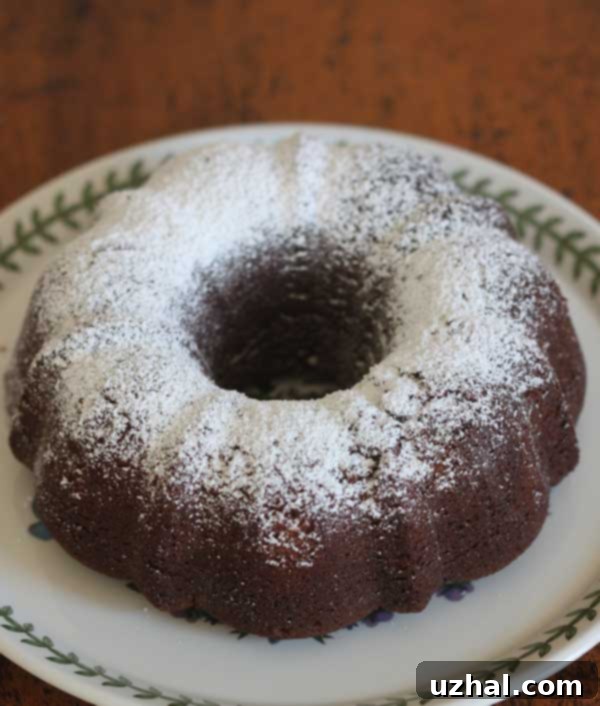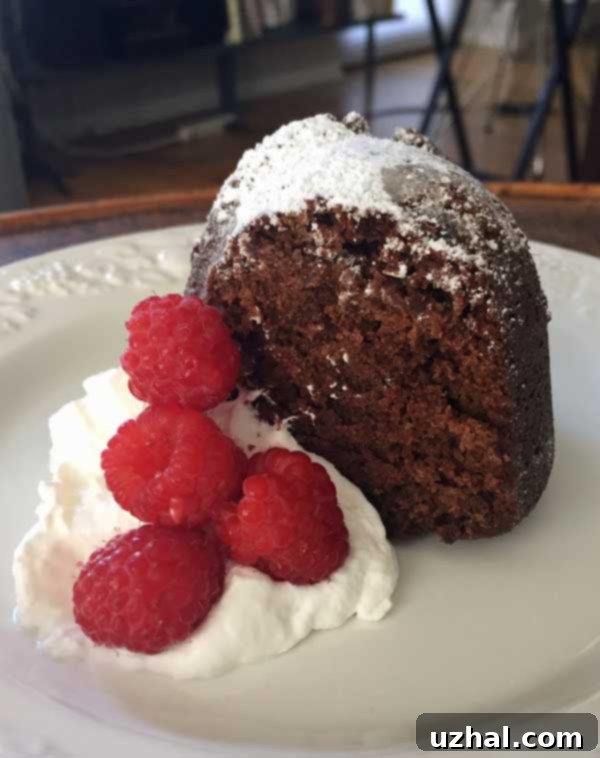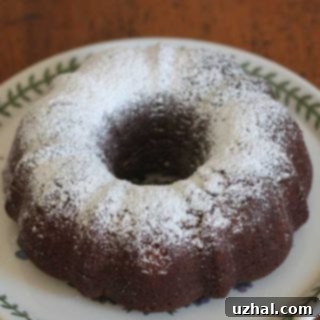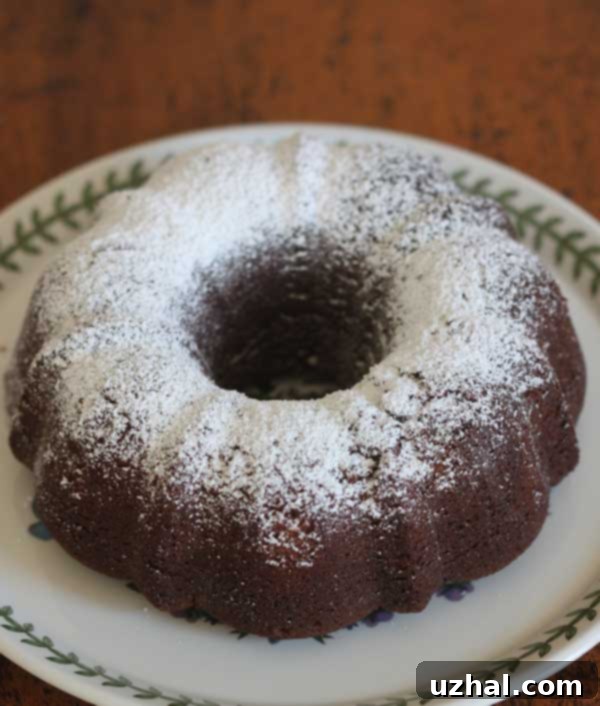Decadent Chocolate Olive Oil Bundt Cake: A Moist & Flavorful Recipe for Your 6-Cup Pan
The inspiration for this remarkably moist and rich chocolate cake struck me during a visit to Trader Joe’s. There, nestled amongst other tempting treats, was a charmingly small chocolate olive oil cake. Its unique combination of flavors immediately piqued my curiosity. Knowing the joy of baking from scratch, I decided to embark on a culinary adventure to create my own version, but with a slight modification to suit a more generous serving.
My initial attempt involved adapting a beloved pound cake recipe, aiming for a similar chocolate olive oil profile in a standard loaf pan. The flavor was absolutely divine – deeply chocolatey with a subtle, intriguing hint of olive oil that added an unparalleled depth and richness. The texture was wonderfully dense and moist, truly a delight to the palate. However, its visual appeal left something to be desired. The top emerged from the oven with an unfortunate flaky, slightly sunken appearance, lacking the elegant dome typically associated with a perfectly baked loaf.
While the taste was undeniably a triumph, I knew the presentation could be significantly improved. For a cake this delicious, it deserved to look as good as it tasted. This led me to a brilliant realization: a Bundt pan! I decided to bake the recipe again, this time in a 6-cup capacity Bundt pan. The result was a revelation! The Bundt pan transformed the humble loaf cake into a beautifully sculpted masterpiece, with its signature fluted design and a wonderfully even bake. This change not only enhanced the cake’s aesthetic but also seemed to contribute to an even more tender and uniform crumb. It was a complete success, confirming that this Chocolate Olive Oil Cake was destined for Bundt glory.

Why a 6-Cup Capacity Bundt Pan is a Kitchen Essential
If you’re an avid baker or simply appreciate the beauty of a well-presented cake, I wholeheartedly recommend adding a 6-cup capacity Bundt pan to your bakeware collection. This smaller size is incredibly versatile and quickly became one of my favorite baking companions. Many standard Bundt recipes are designed for 10-12 cup pans, which can often result in an overwhelming amount of cake for smaller households or if you’re simply looking to indulge without excess. With a 6-cup Bundt, you can effortlessly halve almost any standard Bundt recipe, making it perfect for intimate gatherings, smaller families, or when you just want a modest treat without being left with an abundance of leftovers.
Beyond portion control, the 6-cup Bundt pan opens up a world of creative possibilities. It allows you to experiment with different flavors and recipes more frequently, keeping your baking adventures fresh and exciting. Imagine trying a lemon poppy seed Bundt one week and then this exquisite Chocolate Olive Oil Bundt Cake the next, all without the pressure of having too much dessert on hand. It’s truly a game-changer for home bakers.
No 6-Cup Bundt? No Problem! Alternative Baking Pans
While the 6-cup Bundt pan is ideal for achieving that signature elegant shape, don’t let its absence deter you from trying this phenomenal recipe. You can absolutely use a standard 9×5 inch loaf pan. The top of the loaf won’t have the rounded, fluted charm of a Bundt, and it might retain some of that slightly flaky appearance I encountered initially. However, there’s a simple trick to still make it look appealing: invert the cake! Once cooled, you can carefully flip the Chocolate Olive Oil Loaf Cake upside down before serving. This will reveal a smoother, denser bottom that now serves as the perfect, elegant top. You can then dust it with a little powdered sugar or drizzle a simple ganache for an added touch of sophistication.
For best results, regardless of whether you choose a Bundt or a loaf pan, proper preparation is key. Bundt pans, with their intricate designs, require meticulous greasing and flouring to ensure a clean release. I highly recommend using a baking spray that contains flour, as it helps reach every nook and cranny. Alternatively, you can generously grease the pan with softened butter and then dust it thoroughly with flour, tapping out any excess. For this particularly moist and tender cake, taking extra care with pan preparation will save you from potential sticking and frustration, ensuring your beautiful cake emerges flawlessly. Always allow the cake to cool sufficiently in the pan before attempting to invert it.

The Secret Ingredient: Embracing Olive Oil in Baking
The star of this recipe, undoubtedly, is the olive oil. While it might seem like an unconventional choice for a cake, especially a chocolate one, olive oil imparts an incredible moisture, tenderness, and a unique depth of flavor that butter simply cannot replicate. Its presence creates a cake that is exceptionally moist and stays fresh longer, with a crumb that is both delicate and rich. Olive oil also contributes to a slightly denser, yet incredibly tender, texture that is distinct from butter-based cakes.
Initially, I had some reservations about using our preferred robust, buttery extra virgin olive oil. I worried its strong flavor might overpower the delicate chocolate notes. To mitigate this, my first test batch involved cutting the olive oil with a bit of neutral vegetable oil. The result was good, but not quite perfect. It lacked that distinctive richness and the subtle, peppery undertone I was chasing, which makes an olive oil cake truly special.
However, during my second attempt, encouraged by the cake’s excellent texture, I took a leap of faith and used the full, unadulterated amount of our robust extra virgin olive oil. And what a difference it made! The cake was not only perfectly moist but also boasted an even richer, more complex flavor profile. The olive oil didn’t clash with the chocolate; instead, it harmonized beautifully, adding a subtle fruitiness and a peppery finish that elevated the entire experience. It taught me an important lesson: don’t shy away from using high-quality olive oil in baking. Its flavor truly shines through, transforming a good cake into an extraordinary one.
When selecting olive oil for this recipe, any good quality extra virgin olive oil will work. For those who enjoy a more pronounced flavor, a robust or “buttery” variety will enhance the cake’s complexity. If you prefer a milder taste, a delicate or fruity olive oil will still deliver exceptional moisture without being too forward. The beauty of olive oil is its versatility, allowing you to tailor the subtle nuances of the cake to your personal preference. Moreover, baking with olive oil introduces a healthier fat alternative, adding a touch of Mediterranean goodness to your dessert and often making the cake suitable for those with dairy sensitivities.
Crafting the Perfect Chocolate Olive Oil Cake: Tips for Success
Beyond the choice of pan and olive oil, a few key elements ensure this Chocolate Olive Oil Bundt Cake turns out perfectly every time. Let’s delve into some essential baking tips that will make your experience smooth and successful:
The Magic of Dutch Process Cocoa and Espresso Powder
For a truly rich and deep chocolate flavor, this recipe calls for **Dutch process cocoa powder**. Unlike natural cocoa powder, Dutch process cocoa has been treated with an alkali to neutralize its acidity. This process gives it a darker, more intense color and a smoother, less bitter chocolate flavor, which pairs wonderfully with the subtle notes of olive oil. If you only have natural cocoa, the cake will still be delicious, but the color might be lighter and the flavor profile slightly sharper due to its acidity. The depth of flavor truly comes from the Dutch process variety.
The addition of **instant espresso powder** might seem unusual for a non-coffee cake, but it’s a secret weapon for enhancing chocolate. Espresso doesn’t make the cake taste like coffee; instead, it amplifies the chocolate flavor, making it taste even more intense and profound. It acts as a flavor enhancer, bringing out the best in the cocoa without introducing a distinct coffee flavor. Many professional bakers use this trick! Don’t skip it if you want the most vibrant chocolate taste possible.
Room Temperature Ingredients for a Better Batter
You’ll notice the recipe specifies room temperature eggs and buttermilk. This isn’t just a suggestion; it’s a crucial step for achieving a smooth, well-emulsified batter and a tender crumb. Room temperature ingredients incorporate more easily and uniformly into the mixture, preventing the batter from curdling and creating a more stable emulsion. This leads to a more uniform crumb, a higher, more even rise, and a superior, melt-in-your-mouth texture in the final cake. Plan ahead and take your eggs and buttermilk out of the fridge at least 30 minutes to an hour before you start baking.
Mixing Technique for a Light & Tender Cake
The mixing process is designed to create a light and tender crumb. Beating the eggs and sugar until “thick and lemon colored” is a vital step known as “ribbon stage.” This process incorporates a significant amount of air, which acts as a leavening agent and contributes to the cake’s delicate texture. It provides the initial lift and structure. When adding the dry and wet ingredients alternately, it’s important to mix on the lowest speed or by hand to prevent overmixing. Overmixing can develop the gluten in the flour too much, resulting in a tough, chewy cake. Gently folding ensures everything is just combined, preserving the airy structure created earlier. Stop mixing as soon as no dry streaks remain.
This Chocolate Olive Oil Cake is more than just a dessert; it’s an experience. Its dark, moist crumb, infused with the subtle fruitiness of olive oil and deep chocolate flavor, makes it a sophisticated yet comforting treat. It’s perfect on its own, perhaps dusted with a simple layer of powdered sugar, or elevated with a dollop of whipped cream or a scoop of vanilla bean ice cream. For an extra touch of decadence, consider a light chocolate glaze or a sprinkle of flaky sea salt to really bring out those complex flavors. This cake is ideal for any occasion, from a casual afternoon coffee break to an elegant dinner party. Its unique profile is sure to impress your guests and become a staple in your baking repertoire.
- Lemon Apricot Loaf
- Trader Joe’s Peanut Butter White and Chocolate Chunk Cookies
- Chocolate Peanut Butter Cupcakes Version Two
- Mixed Nut Butter Chocolate Chunk Cookies
- Chocolate Covered Graham Crackers
Chocolate Olive Oil Cake Recipe

Chocolate Olive Oil Cake
Anna
Pin Recipe
Ingredients
- 1 cup plus 2 tablespoons cake flour 4 ½ oz or (130 grams)
- ½ cup unsweetened Dutch process cocoa powder
- ¼ teaspoon baking powder
- ½ teaspoon salt
- 2 teaspoons instant espresso powder
- 2 large eggs at room temperature plus 1 egg yolk
- 1 ½ cups ultrafine granulated sugar (300 grams)
- ⅔ cup extra virgin olive oil
- 1 teaspoon vanilla extract
- ½ cup buttermilk room temperature or milk soured with lemon juice**
Instructions
-
Preheat the oven to 325 degrees F (160 degrees C). Grease and flour a 6-cup capacity Bundt pan meticulously, or spray it generously with a high-quality baking spray that includes flour. Ensure every crevice is coated to prevent sticking.
-
In a medium bowl, sift together the cake flour, Dutch process cocoa powder, and baking powder. This step helps to aerate the dry ingredients and prevent lumps. Whisk in the salt and instant espresso powder until thoroughly combined. Set aside.
-
In the bowl of a stand mixer fitted with the whisk attachment, beat the room temperature eggs and egg yolk on medium-high speed for about 1 minute until slightly foamy. With the mixer still running, gradually add the ultrafine granulated sugar, a little at a time, continuing to beat until the mixture is thick, pale lemon-colored, and forms a ribbon when the whisk is lifted (this usually takes 5-7 minutes). Reduce mixer speed to medium-low and slowly drizzle in the extra virgin olive oil and vanilla extract until just combined. Be careful not to overmix at this stage.
-
With the mixer on the lowest speed, or by hand using a whisk, add the sifted flour mixture and the room temperature buttermilk alternately to the egg mixture. Begin and end with the flour mixture (e.g., flour, buttermilk, flour, buttermilk, flour). Mix only until just combined after each addition; overmixing will result in a dense cake. The batter should be smooth but not overworked.
-
Carefully pour the batter into the meticulously greased and floured Bundt pan. Gently tap the pan on the counter a couple of times to release any air bubbles. Place the Bundt pan on a baking sheet (this makes it easier to transfer and helps catch any potential drips). Bake for approximately 45-60 minutes, or until a cake tester or wooden skewer inserted into the center of the cake comes out clean with no wet batter attached.
-
Once baked, remove the cake from the oven and let it cool in the pan on a wire rack for about 10-15 minutes. This crucial cooling period allows the cake to firm up slightly, making it less likely to break when inverted. After 10-15 minutes, carefully invert the cake onto the wire rack to cool completely. If it sticks, gently tap the bottom of the pan and use a thin offset spatula or knife around the edges if necessary. Allow to cool completely before slicing and serving for the best texture and flavor.
Notes
Critical Pan Preparation: This is a rich and somewhat sticky cake, so truly meticulous greasing and flouring are paramount for a perfect release, especially from an intricate Bundt pan. I cannot stress this enough! If you have a baking spray that contains flour (like Baker’s Joy or Pam Baking), it is highly recommended as it coats every intricate detail of the pan. If using butter and flour, be very generous with the softened butter, making sure it reaches into all crevices, and then dust thoroughly with flour, rotating the pan and tapping out all excess. A thin, even coating is what you’re aiming for. Cold butter can be used, but softened butter is often easier to spread evenly and thoroughly.
Storage: Store the Chocolate Olive Oil Cake at room temperature, covered tightly, for up to 3-4 days. The olive oil helps keep it wonderfully moist and fresh longer than many butter-based cakes. For longer storage, you can freeze individual slices, well-wrapped in plastic wrap and then foil, for up to 2 months. Thaw at room temperature before serving.
Frequently Asked Questions About Chocolate Olive Oil Cake
Can I use regular all-purpose flour instead of cake flour?
While cake flour is recommended for its lower protein content, which contributes to a more tender and delicate crumb, you can substitute it with all-purpose flour in a pinch. To do so, for every cup of cake flour, use 1 cup of all-purpose flour minus 2 tablespoons, and then add 2 tablespoons of cornstarch to the all-purpose flour. Sift this mixture together a few times to ensure it’s well combined. This substitute helps to mimic the texture of cake flour, though the result might be slightly less tender. For the best results, however, sticking to cake flour is ideal.
What if I don’t have buttermilk?
No problem at all! You can easily make a buttermilk substitute at home. For the ½ cup of buttermilk required in this recipe, simply add 1 teaspoon of fresh lemon juice or white vinegar to a ½-cup measuring cup. Then, fill the rest of the cup with regular milk (whole milk or 2% works best for richness). Stir it gently and let it sit for 5-10 minutes until it slightly curdles and thickens. Your homemade “buttermilk” is now ready to use! Just ensure it’s at room temperature before adding it to the cake batter to ensure proper emulsification.
How important is the espresso powder? Will my cake taste like coffee?
The instant espresso powder is a secret weapon for enhancing chocolate flavor, not for making the cake taste like coffee! It acts as a flavor intensifier, deepening the chocolate notes and making the cake taste richer and more profoundly chocolatey without a discernible coffee flavor. While you can omit it if you absolutely must, I highly recommend including it for the best possible chocolate experience. You won’t regret the added depth it brings, and your cake won’t taste like a mocha.
How should I store leftover Chocolate Olive Oil Cake?
Thanks to the olive oil, this cake stays incredibly moist and fresh. Store it at room temperature, wrapped tightly in plastic wrap or kept under a cake dome, for up to 3-4 days. For longer storage, you can slice the cake into individual servings, wrap each slice tightly in plastic wrap, then place them in an airtight freezer-safe bag or container. It will keep beautifully in the freezer for up to 2 months. Thaw frozen slices at room temperature for a few hours before enjoying, or gently warm them for a fresh-baked feel.
What are good serving suggestions for this cake?
This Chocolate Olive Oil Cake is exquisitely flavorful on its own, and a simple dusting of powdered sugar is often all it needs for an elegant presentation. For added flair, you can serve it with a dollop of freshly whipped cream, a scoop of premium vanilla bean ice cream, or a fresh berry compote (raspberries or strawberries pair wonderfully). A light chocolate ganache or a sprinkle of flaky sea salt (like Maldon) can also elevate its flavor profile, creating a delightful contrast between sweet, bitter, and savory. It pairs beautifully with a cup of strong coffee, a delicate Earl Grey tea, or even a robust red wine.
Let me know what you think of this Decadent Chocolate Olive Oil Bundt Cake!
I hope you thoroughly enjoy baking and savoring this unique Chocolate Olive Oil Bundt Cake. It’s truly a labor of love that balances deep chocolate indulgence with the sophisticated nuances of high-quality olive oil, resulting in a cake that is both familiar and excitingly new. I’d love to hear your thoughts and experiences with this recipe, any modifications you tried, or what your family and friends thought, in the comments section below. Happy baking!
